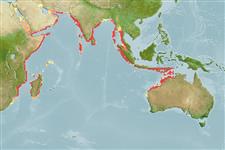Actinopterygii (ray-finned fishes) >
Siluriformes (Catfish) >
Ariidae (Sea catfishes) > Ariinae
Environment / Climate / Range
Ecology
Marine; freshwater; brackish; demersal; depth range 20 - 50 m (Ref. 28016). Tropical, preferred ?
Indo-west Pacific: Mozambique and Madagascar to Sri Lanka, the east coast of India, Bangladesh, Myanmar to Sumatra (Ref. 56505).
Size / Weight / Age
Maturity: Lm ? range ? - ? cm
Max length : 62.0 cm SL male/unsexed; (Ref. 4967); max. published weight: 1.4 kg (Ref. 4883)
Anal
soft rays: 14 - 16. It has a prominent lateral ethmoid that forms a "shelf" between the eye and the nostrils (Ref. 56505), two pairs of vomerine toothpletes (Ref. 56505), and a very short adipose-fin base (Ref. 56505). Body dark brown, lower surfaces completely covered with fine brown pigment specks (Ref. 3976).
Found along the coast (Ref. 5213). Enters the lower parts of rivers of the east coast of Africa (Ref. 3876). Feeds on invertebrates and small fishes. Marketed fresh and dried-salted (Ref. 3290). Males incubate eggs in its mouth(Ref. 68964). Air bladder utilized for isinglass.
Life cycle and mating behavior
Maturity | Reproduction | Spawning | Eggs | Fecundity | Larvae
Jayaram, K.C., 1984. Ariidae. In W. Fischer and G. Bianchi (eds.) FAO species identification sheets for fishery purposes. Western Indian Ocean fishing area 51. Vol. 1. FAO, Rome. pag. var. (Ref. 3290)
IUCN Red List Status (Ref. 115185)
CITES (Ref. 94142)
Not Evaluated
Threat to humans
Traumatogenic (Ref. 58010)
Human uses
More information
Common namesSynonymsMetabolismPredatorsEcotoxicologyReproductionMaturitySpawningFecundityEggsEgg development
Tools
Special reports
Download XML
Internet sources
